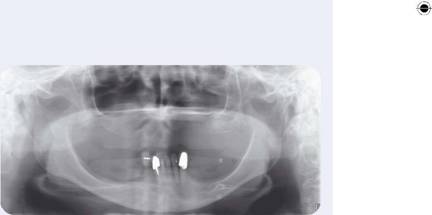
Treatment of a patient with implant-supported fixed complete denture prostheses
Selection of appropriate design of prostheses that can be maintained requires understanding of the mechanical properties of prostheses, oral physiology, and anatomy. This combined knowledge will help clinicians make treatment decisions that will succeed. In this chapter, implant-supported prostheses and smoking habit and their effect on the overall long-term treatment success are discussed.
CASE STORY
A 43-year-old female presents with the chief complaint of “I cannot chew with my back teeth.” The patient was very concerned with aesthetics and the fit of her mandibular partial denture, and she wanted a more stable prosthesis for her mandible.
Figure 1: Pretreatment frontal view.

Figure 2: Pretreatment frontal intraoral view.

Figure 3: Panoramic radiograph.

LEARNING GOALS AND OBJECTIVES
- I dentify the common complications in implant- supported fixed completed denture prostheses.
- I dentify factors influencing the generated preload between the implant and implant-abutment.
- Learn the effect of smoking on osseointegration of dental implants in the maxilla and mandible.
Medical History
- No significant findings
Dental History
- The existing prostheses were made 5 years ago.
Social History
- Smoking: for the past 20 years, 1 pack per day
Clinical Findings/Problem list
- Smoking habit
- I nadequate maxillary complete denture
- I nadequate posterior occlusion with the existing prostheses
- Severely resorbed mandibular posterior ridge
- Periodontally compromised remaining mandibular dentition
Radiographic Findings
- Widening of periodontal ligament (PDL) space
- Generalized bone loss around the remaining mandibular dentition
Diagnosis
- Complete edentualism in maxilla
- Defective restorations and prostheses
- Recurrent caries
- Chronic moderate to severe adult periodontitis
Clinical Decision-Making Determining Factors
- The use of implant-supported fixed complete denture prostheses has been shown as a viable option for rehabilitating the missing soft and hard tissue structures (Naert, Quirynen et al. 1992).
- A common and frequently reported complication of implant-supported prostheses is loosening of abutment or prosthetic screws (Jemt 1991; Naert, Quirynen et al. 1992; Goodacre, Bernal et al. 2003).
- Preload refers to the degree of tightness of a screw-in implant. The key factors influencing preload are the applied torque and coefficient of friction between the screw threads and implant (Guda, Ross et al. 2008).
- The reduction of coefficient of friction on abutment screws can generate greater preload values (Martin, Woody et al. 2001).
- The maintenance of initially generated preload is influenced by the passive-fit of implant-supported framework and careful control of occlusion (Adell, Lekholm et al. 1981; Kallus and Bessing 1994).
- Smoking, especially during the healing phase, has been associated with a higher implant failure rate (Bain and Moy 1993; Lambert, Morris et al. 2000; Bain, Weng et al. 2002).
- The risks of implant failures and biological complications with and without accompanying augmentation procedures was found to be significantly increased in smokers compared with nonsmokers (Klokkevold and Han 2007; Abt 2009).
- Use of surface-treated implants has been suggested in smokers and was shown to have less impact on the prognosis of implants (B/>
Stay updated, free dental videos. Join our Telegram channel

VIDEdental - Online dental courses


